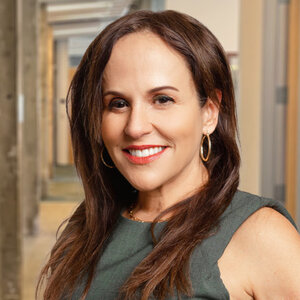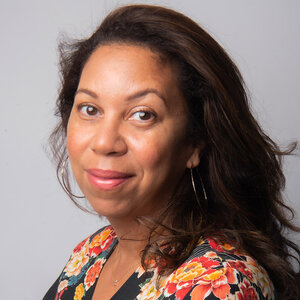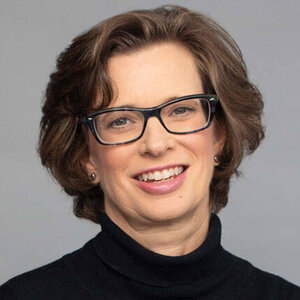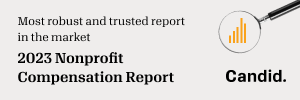Fay Twersky, President and Director, Arthur M. Blank Family Foundation: $1 billion in grantmaking and focused on the future
May 4, 2023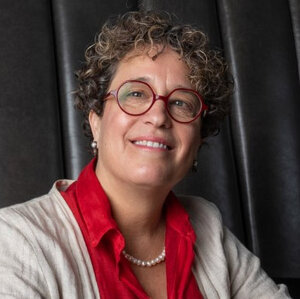
Fay Twersky has spent her entire career in and around nonprofits and foundations. She realized relatively early on that for philanthropy to be effective, funding decisions required more than simply evaluating a grant application.
Before joining the Arthur M. Blank Family Foundation as president and director in early 2021, Twersky served as vice president of the William and Flora Hewlett Foundation, where she managed special initiatives aimed at improving the foundation’s grantmaking and created and led its Effective Philanthropy Group, which guides strategy, evaluation, and organizational learning, as well as grantmaking in support of organizational effectiveness and a strong philanthropic sector. Twersky also has held leadership positions with Yad Hanadiv (the Rothschild Foundation) and the Bill & Melinda Gates Foundation, where she created the YouthTruth student survey in partnership with the Center for Effective Philanthropy. Later, she helped launch the Fund for Shared Insight and its signature initiative, Listen4Good, which promotes high-quality listening and feedback in service of equity.
Philanthropy News Digest spoke with Twersky about the Blank Foundation passing the milestone of $1 billion in grantmaking, the future of the foundation, and the importance of listening to all those served by philanthropic organizations.
Philanthropy News Digest: The Blank Foundation may not be as widely known as some of the others where you’ve worked, but $1 billion makes a significant difference in the lives of people. What has been the driving force in the foundation as it has worked to make this kind of impact?
Fay Twersky: I would say Arthur Blank’s values. He’s a very values-driven person. His children, who are also involved in the philanthropy, share his values; they’re very values-driven people. His core values are everywhere at the foundation. [She holds up a stack of coasters, on which the foundation’s core values are printed along the edge.] We talk about them all the time. We reference them at different points. One of the values is “Give back to others.” It is nested in a lot of other values: “Put people first,” “Listen and respond,” “Include everyone,” “Lead by example,” and “Innovate continuously.” I would say it is really those values that drive Arthur and the family to make the world a better place.
The only other value I would add to that is Arthur’s Jewish faith and the family that he came from. The value of Tikkun olam, of healing and repairing the world, is a value that he will often reference. It’s one that resonates for me, and we also reference it as an animating purpose for why we’re in the business of trying to help communities thrive.
PND: Was it those values that drove you to join the Blank Foundation?
FT: There are a few things that drew me to this opportunity. One was the issues they had chosen to focus on in this next chapter of giving. Another was being in Atlanta. But in a way, you’re right: Who you work with matters. At the end of the day, that was what made my decision easy: I admired and aligned with the values of Arthur and the family.
PND: What were the grants or focus areas that put the foundation over the $1 billion mark? Was there a specific issue the foundation chose to put it over the milestone?
FT: They were all grants we made in the last three months that are emblematic of the various issue areas that we work on. They’re all significant, and they’re all illustrative of the kind of work we do, both in the priority areas as well as in the Founder Initiatives. And then we have a special giving area called the Molly Blank Fund, which is a special fund devoted to the interest areas of Arthur’s mother.
PND: The foundation lists five areas of giving: Youth Development, Democracy, the Environment, Mental Health and Well-Being, and Westside Atlanta. That might seem like a lot for some foundations, but it also has multiple Founder Initiatives. How does the foundation maintain its focus when it is working in so many areas?
[Each focus area is] working on different problems, but together, all of those challenges represent parts of each of the communities we live in. It’s like saying: How can you work with five fingers, isn’t it too many? They’re five areas, but they all represent existential issues.
FT: The family selected areas that they are passionate about and that they wanted to work on. Within each of them, we have a lead. And within each of those areas, we’ve determined what our focus should be. What’s the problem we want to solve or contribute to solving? We can’t do everything within youth development, or certainly within democracy or climate change. We study to understand the problem and we develop a strategy that is laser-focused on that problem. That’s a discipline we bring to each of those areas. We have small, nimble teams for each of those areas, and when you do it that way, it feels like we are very focused. They’re each working on different problems, but together, all of those challenges represent parts of each of the communities we live in. It’s like saying: How can you work with five fingers, isn’t it too many? They’re five areas, but they all represent existential issues.
PND: Do you have to balance the portfolios, the budgets that each gets? Does it shift from year to year? How do you determine that?
FT: We’re still in the process of creating all of our systems. We’re re-charting that for the future. We have a certain amount of predictability from year to year. We have a five-year outlook in terms of our strategies; our strategies are 10-year strategies, and we have five-year budget strategies. And then we have some sense of predictability about how much resources we’ll have to work against particular problems.
PND: I think you’d agree that one of the most important ways to make an impact in philanthropy is to listen to what is needed and determine where and how you can meet those needs. But what we don’t often hear people talk about is who needs to be listened to. When you were at the Gates Foundation, you helped it not only to listen to its grantees but also to the people those grantees were serving. Can you talk about the challenges foundations face in expanding the number of voices they listen to, and how they need to understand what is being said?
FT: Yes, that’s a passionate area for me. In fact, when I was interviewing for this job [in 2020] and I met with Arthur, he had read something about the Listen4Good initiative, and he said, “Fay, I want you to know, I’ve been ‘listening for good’ my whole life.”
And he has. The “listen and respond” value I cited earlier is one that Arthur holds dear. He believes, whether it’s Home Depot customers or community members on the Westside [of Atlanta], listening to understand and responding is really important to his ethos and to what we’re trying to accomplish here at the foundation.
It’s not easy. What has been challenging for foundations is that they can sometimes be a few steps removed from the communities that they’re seeking to help. I think there used to be other barriers in the field of maybe not valuing community perspective. I think that’s changing, actually. Foundations are recognizing the value and there is a lot of interest in doing more listening—not just to grantees but also to the communities that we’re here to serve and to benefit.
Foundations are recognizing the value and there is a lot of interest in doing more listening—not just to grantees but also to the communities that we’re here to serve and to benefit.
That experience that you referenced when I was at the Gates Foundation—part of my role helping the foundation hear from outside voices—we were good at hearing from experts; we were getting better at hearing from grantees. But we weren’t as good at hearing from the people we were ultimately trying to help. That insight led me to start the YouthTruth work, which was listening to the students and the schools that the Gates Foundation had been funding. We were trying to create vehicles that funders could use that would provide them with reliable and authentic feedback on how those we were seeking to benefit were experiencing the things that we were funding, their ideas for how to improve it, and what else they needed.
Then, after leaving there and being at Hewlett and starting work with the Fund for Shared Insight, which is a funder collaborative devoted to exactly this, we developed our signature tool, Listen4Good. Listen4Good is an elegant vehicle for gaining feedback from the nonprofit customer—the people intended to benefit from the services and products that nonprofits deliver. Having those insights that derive from Listen4Good find their way to the funders as well, so the funders can understand what it is that the real folks are experiencing and what would make things better from their perspective, their insights, ideas, and preferences.
One of the first things we did at the Blank Foundation when I arrived was launch a Listen4Good initiative with grantees, inviting all those who wanted to participate to do so. We’ve been in a year-and-a-half-long process with them, convening them all together in person. We still have distance to travel, but we aspire to build that practice into what we do here at each step of implementation.
PND: Does Listen4Good work better for any particular type of nonprofit? Is it best suited for direct service? Does it work for an infrastructure group? How do the various types of nonprofits out in the world fit into that type of relationship?
FT: When we launched Listen4Good, it was with the idea that we would begin with direct service organizations. We said, “Let’s start with the low-hanging fruit.” Here’s an opportunity to help out a large swath of the nonprofit sector who want to listen and who often does already. Here’s an opportunity to do it better, simpler, benchmark more rigorously, and so forth. The tool itself can be used to understand the perspectives of volunteers, for instance. They can be used in advocacy. One of the things that we did when I was with Fund for Shared Insight was commission a landscape report to understand how advocacy organizations listen to the constituents that they’re supposed to be representing.
Listen4Good does one thing really, really well. It doesn’t do everything. There are other mechanisms for listening to communities as you’re developing strategy, refreshing strategy—that’s some of what we’re trying to do at the Blank Foundation, too, as we’re developing strategies in all the different areas, even if they’re not direct service-related. How do we listen to community, be thoughtful, integrate their views as we’re making choices along the way?
How do we listen to community, be thoughtful, integrate their views as we’re making choices along the way?
PND: Getting back to the Blank Foundation, a billion dollars is a lot of money, but I doubt it’s going to take you another 30 years to reach $2 billion. What do the next 10 to 15 years look like for the foundation?
FT: I’m not going to make an exact prediction, but I can say that when the foundation started in 1995, our first year of grantmaking we made $5.4 million in grants. These past few years, we were awarding at about $100 million per year. Arthur has pledged to give half his wealth away, and we’re accelerating our giving. We’re working out now what the exact rate will be. But we will continue to accelerate.
PND: And it’ll be in the same focus areas that you already have, or will there be an expansion of that?
FT: That’s a good question. The five areas we’re focused on now and founder initiatives are going to be our focus for the near term, but the world continues to change. So if we feel we’ve successfully completed our work in an area and the world has changed and brings an opportunity to do something in another area, I could imagine that could happen. But for now, we have our work cut out for us in the areas that we’ve chosen.
— Matt Sinclair


